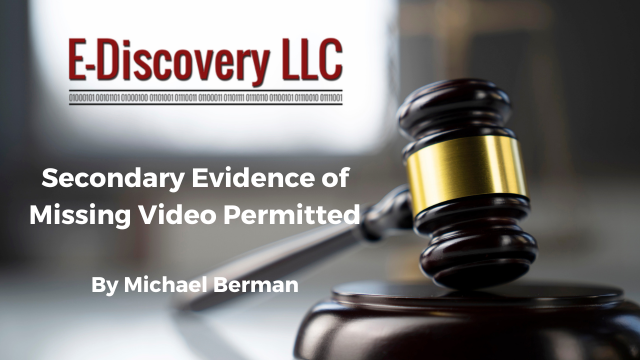
In Brooks-Anderson v. State, 2023 WL 3834829 (Apl. Ct. Md. Jun. 6, 2023)(unreported), defendant had been convicted of theft from Loomis Armored U.S., a cash transport company. The victim was the former-employer of the defendant.
At trial, the State played one video of Brooks-Anderson taking bags filled with cash out of a cage and organizing them on a cart, and another of him loading bags from the cart to the truck. In addition to the video played at trial, the State’s witnesses testified, over Brooks-Anderson’s objection, about portions of the security footage that were not played at trial or made available to either Brooks-Anderson or the State. On appeal, Brooks-Anderson contends that the circuit court erred in allowing this testimony because it violated the best-evidence rule. We disagree. [emphasis added]
Brooks-Anderson v. State, 2023 WL 3834829 (Apl. Ct. Md. Jun. 6, 2023)(unreported).
Maryland Rule 5-1002, states: “To prove the content of a writing, recording, or photograph, the original writing, recording, or photograph is required, except as otherwise provided in these rules or by statute.”
However, the contents of the original may be “proved by evidence other than the original” if the original has been lost or destroyed. Md. Rule 5-1004(a). Thus, if a foundation is laid, secondary evidence is admissible. The Court wrote that:
Indeed, any reason short of “intentional destruction to gain an unfair advantage” will suffice to allow use of secondary evidence. State v. Cabral, 159 Md. App. 354, 385 (2004) (“Carelessness, recklessness, ordinary negligence, and even gross negligence are all satisfactory explanations for the absence of an original.” (cleaned up)).
Id.
On the facts presented, the Appellate Court held that:
Here, the State was never in possession of any Loomis video footage other than that played at trial. One of the State’s witnesses described the nature of the surveillance video system at Loomis and testified that the camera software retained video for “90 plus days,” which is “industry standard.” Although none of the witnesses personally witnessed the events on the missing footage, they all personally reviewed the footage itself. Ultimately, however, the witnesses were only asked to download and save the portions of footage given to the State and played at trial. In the course of their investigation, employees of Loomis determined that footage was all that was pertinent to the case, and they had failed to retain other footage that did not show anything out of the ordinary. After the retention period lapsed, the remaining footage ceased to exist. There is nothing in the record to suggest that the decision to retain only some of the footage was made “intentional[ly]” with the purpose of “gain[ing] an unfair advantage.” Id. (cleaned up). The trial court, therefore, did not abuse its discretion in allowing testimony of individuals who had viewed the footage as secondary evidence.
For more on Rule 5-1004 and secondary evidence, see. M. Berman and R. Shapiro in M. Berman, et al., eds., “Electronically Stored Information in Maryland Courts” (Md. State Bar Ass’n. 2020), Apx. F. Procedures under the Federal Rule were discussed in Lorraine v. Markel Am. Ins. Co., 241 F.R.D. 534, 582 (D. Md. 2007).
Md. Rule 5-1004 states:
The contents of a writing, recording, or photograph may be proved by evidence other than the original if:
(a) Original Lost or Destroyed. All originals are lost or have been destroyed, unless the proponent lost or destroyed them in bad faith;
(b) Original Not Obtainable. No original can be obtained by any reasonably practicable, available judicial process or procedure;
(c) Original in Possession of Opponent. At a time when an original was under the control of the party against whom offered, that party was put on notice, by the pleadings or otherwise, that the contents would be a subject of proof at the hearing or trial, and that party does not produce the original at the hearing or trial; or
(d) Collateral Matters. The writing, recording, or photograph is not closely related to a controlling issue.
Md. Rule 5-1004.
Fed.R.Evid. 1004 states:
An original is not required and other evidence of the content of a writing, recording, or photograph is admissible if:
(a) all the originals are lost or destroyed, and not by the proponent acting in bad faith;
(b) an original cannot be obtained by any available judicial process;
(c) the party against whom the original would be offered had control of the original; was at that time put on notice, by pleadings or otherwise, that the original would be a subject of proof at the trial or hearing; and fails to produce it at the trial or hearing; or
(d) the writing, recording, or photograph is not closely related to a controlling issue.
Fed.R.Evid. 1004.
Of course, secondary evidence now expressly may play a role in the December 2015 amendments to Fed.R.Civ.P. 37(e) and the 2023 amendments to Md. Rule 2-433(b).[1]


